A Study of the Foremen’s Influence on the Safety Behavior of Construction Workers Based on Cognitive Theory
Abstract
:1. Introduction
1.1. Background
1.2. Research Review
1.2.1. Safety Behavior
1.2.2. Agent-Based Modeling in Construction Research
2. Methodology
2.1. Research Framework
2.1.1. Behavioral Influence Model Development
- General concept
- Agents’ properties
- Workers’ cognitive properties
- 2.
- Foreman’s behavior properties
- Agents’ interaction
- Foreman–worker behavioral interaction
- 2.
- Model interaction rules
2.1.2. Data Acquisition
- Site environment
- Worker’s behavior assessment
3. Model Application and Evaluation
3.1. ABM
3.2. Model Validation
3.3. Scenario Analysis
4. Discussion and Conclusions
Author Contributions
Funding
Data Availability Statement
Conflicts of Interest
References
- Huang, J.L.; Wu, Y.D.; Han, Y.; Yin, Y.; Gao, G.B.; Chen, H.H. An evolutionary game-theoretic analysis of construction workers’ unsafe behavior: Considering incentive and risk loss. Front. Public Health 2022, 10, 991994. [Google Scholar] [CrossRef] [PubMed]
- Ibrahim, A.; Nnaji, C.; Shakouri, M. Influence of Sociodemographic Factors on Construction Fieldworkers’ Safety Risk Assessments. Sustainability 2022, 14, 111. [Google Scholar] [CrossRef]
- U.K. Health and Safety Executive, Fatal Injuries Arising from Accidents at Work in Great Britain. Available online: http://www.hse.gov.uk/statistics/fatals.htm (accessed on 1 June 2023).
- Korea Occupational Safety and Health Agency (KOSHA). Quarterly Status of Industrial Accidents at the End of March 2023. Available online: https://www.moel.go.kr/policy/policydata/view.do?bbs_seq=20230501399 (accessed on 27 May 2023).
- Health and Safety Executive HSE. Strategies to Promote Safe Behavior as Part of a Health and Safety Management System; Contract Research; Rep. No. 430; HSE Books: Merseyside, UK, 2002. Available online: https://www.hse.gov.uk/research/crr_pdf/2002/crr02430.pdf.51 (accessed on 2 June 2023).
- Ni, G.; Lv, L.; Wang, S.; Miao, X.; Fang, Y.; Liu, Q. Formation Mechanism and Dynamic Evolution Laws About Unsafe Behavior of New Generation of Construction Workers Based on China’s Construction Industry: Application of Grounded Theory and System Dynamics. Front. Psychol. 2022, 13, 888060. [Google Scholar] [CrossRef] [PubMed]
- Li, P.; He, Y.; Li, Z. Study on Influencing Factors of Construction Workers’ Unsafe Behavior Based on Text Mining. Front. Psychol. 2022, 13, 886390. [Google Scholar] [CrossRef]
- Peng, L.; Chan, A.H.S. Exerting Explanatory Accounts of Safety Behavior of Older Construction Workers within the Theory of Planned Behavior. Int. J. Environ. Res. Public Health 2019, 16, 3342. [Google Scholar] [CrossRef] [Green Version]
- Suraji, A.; Duff, A.R.; Peckitt, S.J. Development of causal model of construction accident causation. J. Constr. Eng. Manag. 2001, 127, 337–344. [Google Scholar] [CrossRef]
- Newaz, M.T.; Davis, P.; Jefferies, M.; Pillay, M. Examining the psychological contract as mediator between the safety behavior of supervisors and workers on construction sites. J. Constr. Eng. Manag. 2020, 146, 04019094. [Google Scholar] [CrossRef]
- Barrios, A.; Silvia, C.; Masalan, A.; Maria, P.; Ferrada, C.; Ximena, V.; Campos-Romero, S.C.; Molina, M.; Yerko, P. Sleep Quality and Fatigue in Construction Workers: Effect of a Cognitive Behavioral Intervention. J. Occup. Environ. Med. 2023, 65, 235–241. [Google Scholar] [CrossRef]
- Kim, N.B.A.; Anderson, C.R.A. Reducing risk habituation to struck-by hazards in a road construction environment using virtual reality behavioral intervention. J. Constr. Eng. Manag. 2021, 147, 04021157. [Google Scholar] [CrossRef]
- Fang, D.P.; Chunlin, W.; Haojie, W. Impact of the supervisor on worker safety behavior in construction projects. J. Manag. Eng. 2015, 31, 04015001. [Google Scholar] [CrossRef]
- Cedstrand, E.; Nyberg, A.; Bodin, T. Study protocol of a co-created primary organizational-level intervention with the aim to improve organizational and social working conditions and decrease stress within the construction industry—A controlled trial. BMC Public Health 2020, 20, 424. [Google Scholar] [CrossRef] [PubMed] [Green Version]
- Zhang, P.; Li, N.; Jiang, Z.; Fang, D.P.; Anumba, C.J. An agent-based modeling approach for understanding the effect of worker-management interactions on construction workers’ safety-related behaviors. Autom. Constr. 2019, 97, 29–43. [Google Scholar] [CrossRef]
- Kines, P.; Andersen, L.P.S.; Spangeonberg, S.; Mikkelsen, K.L.; Dyreborg, J.; Zohar, D. Improving construction site safety through leader-based verbal safety communication. J. Saf. Res. 2010, 41, 399–406. [Google Scholar] [CrossRef] [PubMed]
- Stajkovic, D.A.; Luthans, F. Behavioral management and task performance in organizations: Conceptual background, meta-analysis, and test of alternative models. Pers. Psychol. 2003, 56, 155–194. [Google Scholar] [CrossRef] [Green Version]
- Zohar, D. The effects of leadership dimensions, safety climate, and assigned priorities on minor injuries in work groups. J. Organ. Behav. 2002, 3, 75–92. [Google Scholar] [CrossRef]
- Ajzen, I. The theory of planned behavior. Organ. Behav. Hum. Decis. Process. 1991, 50, 179–211. [Google Scholar] [CrossRef]
- Fang, D.P.; Zhao, C.; Zhang, M.C. A cognitive model of construction workers’ unsafe behaviors. J. Constr. Eng. Manag. 2016, 142, 04016039. [Google Scholar] [CrossRef]
- Burke, M.J.; Signal, S.M. Workplace safety: A multilevel, interdisciplinary perspective. Res. Pers. Hum. Resour. Manag. 2010, 29, 1–47. [Google Scholar]
- Neal, A.; Griffin, M.A. A study of the lagged relationships among safety climate, safety motivation, safety behavior, and accidents at the individual and group levels. J. Appl. Psychol. 2006, 91, 946–953. [Google Scholar] [CrossRef] [Green Version]
- Rnic, K.; Dozois, D.J.A. Treatment-relevant assessment in cognitive-behavioral therapy. In The Science of Cognitive Behavioral Therapy; Hofmann, S.G., Asmundson, G.J.G., Eds.; Academic Press: Cambridge, MA, USA, 2017; Volume 2, pp. 19–50. [Google Scholar]
- Ilya, G. AnyLogic 7 in Three Days, 3rd ed.; CreateSpace Independent Publishing Platform: Charleston, SC, USA, 2015; pp. 7–100. [Google Scholar]
- Khosravi, Y.H.; Asilian-Mahabadi, E.; Hajizadeh, N.; Hassanzadeh-Rangi, H.; Bastani, A.H.B. Factors influencing unsafe behaviors and accidents on construction sites: A review. Int. J. Occup. Saf. Ergon. 2015, 20, 111–125. [Google Scholar] [CrossRef]
- Liu, X.; Huang, G.; Huang, H.; Wang, S.; Xiao, Y.; Chen, W. Safety climate, safety behavior, and worker injuries in the Chinese manufacturing industry. Saf. Sci. 2015, 78, 173–178. [Google Scholar] [CrossRef]
- Guo, B.H.; Yiu, T.W.; González, V.A. Predicting safety behavior in the construction industry: Development and test of an integrative model. Saf. Sci. 2016, 84, 1–11. [Google Scholar] [CrossRef]
- Chen, D.; Tian, H. Behavior Based Safety for Accidents Prevention and Positive Study in China. Constr. Proj. Procedia Eng. 2012, 43, 528–534. [Google Scholar] [CrossRef] [Green Version]
- Shuquan, L.; Xiuyu, W.; ASCE, S.M.; Xuezhao, W.; Songhe, H. Relationship between Social Capital, Safety Competency, and Safety Behaviors of Construction Workers. J. Constr. Eng. Manag. 2020, 146, 04020059. [Google Scholar]
- Dong-Phil, S.; Han-Seong, G.; Dong-Eun, L. Modeling the predictors of safety behavior in construction workers. Int. J. Occup. Saf. Ergon. 2015, 21, 298–311. [Google Scholar]
- Xiang, Q.; Ye, G.; Liu, Y.; Miang Goh, Y.; Wang, D.; He, T. Cognitive mechanism of construction workers’ unsafe behavior: A systematic review. Saf. Sci. 2023, 159, 106037. [Google Scholar] [CrossRef]
- Shuwen, D.; Honglei, Z.; Rui, P.; Yonggang, P. Development and validation of a cognitive model-based novel questionnaire for measuring potential unsafe behaviors of construction workers. Int. J. Occup. Saf. Ergon. 2022, 28, 2566–2573. [Google Scholar]
- Ye, G.; Yue, H.; Yang, J.; Li, H.; Xiang, Q.; Fu, Y.; Cui, C. Understanding the Sociocognitive Process of Construction Workers’ Unsafe Behaviors: An Agent-Based Modeling Approach. Int. J. Environ. Res. Public Health 2020, 17, 1588. [Google Scholar] [CrossRef] [PubMed] [Green Version]
- Mahnaz, S.; Alireza, C.; Mehdi, J.; Jafar, H.; Mohammad, N. Is ‘invisible gorilla’ self-reportedly measurable? Development and validation of a new questionnaire for measuring cognitive unsafe behaviors of front-line industrial workers. Int. J. Occup. Saf. Ergon. 2021, 27, 852–866. [Google Scholar]
- Griffin, M.A.; Hu, X. How leaders differentially motivate safety compliance and safety participation: The role of monitoring, inspiring, and learning. Saf. Sci. 2013, 60, 196–202. [Google Scholar] [CrossRef]
- Wilensky, U.; Rand, W. What Is Agent-Based Modeling? An Introduction to AgentBased Modeling; The MIT Press: Cambridge, MA, USA, 2015; pp. 21–44. [Google Scholar]
- Ahmed, Y.; Mohaned, M. Tower Cranes Layout Planning Using Agent-Based Simulation Considering Activity Conflicts. Autom. Constr. 2018, 93, 348–360. [Google Scholar]
- Khodabandelu, A.; Park, J. Agent-based modeling and simulation in construction. Autom. Constr. 2021, 131, 103882. [Google Scholar] [CrossRef]
- Mahjoubpour, B.; Nasirzadeh, F.; Golabchi, M.M.H.Z.; Khajehghiasi, M.R.; Mir, M. Modeling of workers’ learning behavior in construction projects using agent-based approach: The case study of a steel structure project. Eng. Constr. Archit. Manag. 2018, 25, 559–573. [Google Scholar] [CrossRef] [Green Version]
- Du, J.; El-Gafy, M. Virtual Organizational Imitation for Construction Enterprises: Agent-Based Simulation Framework for Exploring Human and Organizational Implications in Construction Management. J. Comput. Civ. Eng. 2012, 26, 282–297. [Google Scholar] [CrossRef]
- Li, Z.; Lv, X.; Zhu, H.; Sheng, Z. Analysis of Complexity of Unsafe Behavior in Construction Teams and a Multiagent Simulation. Complexity 2018, 2018, 6568719. [Google Scholar] [CrossRef]
- Macal, M.C.; North, M.J. Tutorial on agent-based modeling and simulation. J. Simul. 2010, 4, 151–162. [Google Scholar] [CrossRef]
- Zohar, D.; Luria, G. The use of supervisory practices as leverage to improve safety behavior: A cross-level intervention model. J. Saf. Res. 2003, 34, 567–577. [Google Scholar] [CrossRef]
- Lu, M.; Cheung, C.M.; Li, H.; Hsu, S.C. Understanding the relationship between safety investment and safety performance of construction projects through agent-based modeling. Accid. Anal. Prev. 2016, 94, 8–17. [Google Scholar] [CrossRef]
- Xiong, C.; Liang, K.; Luo, H.; Fung, I.W.H. Identification of Safety-Related Opinion Leaders among Construction Workers: Evidence from Scaffolders of Metro Construction in Wuhan, China. Int. J. Environ. Res. Public Health 2018, 15, 2176. [Google Scholar] [CrossRef] [Green Version]
- Jarkas, A.M. Critical investigation into the applicability of the learning curve theory to rebar fixing labor productivity. J. Constr. Eng. Manag. 2010, 136, 1279–1288. [Google Scholar] [CrossRef]
- Hijazi, A.M.; Abourizk, S.M.; Halpin, D.W. Modeling and simulating learning development in construction. J. Constr. Eng. Manag. 1992, 118, 685–700. [Google Scholar] [CrossRef]
- Abar, S.; Theodoropoulos, G.K.; Lemarinier, P.; O’Hare, G.M. Agent based modelling and simulation tools: A review of the state-of-art software. Comp. Sci. Rev. 2017, 24, 13–33. [Google Scholar] [CrossRef]
- Zhao, N.; An, S. Collaborative management of complex major construction projects: AnyLogic-based simulation modeling. Discrete Dyn. Nat. Soc. 2016, 2016, 6195673. [Google Scholar] [CrossRef] [Green Version]
- Goh, Y.M.; Ali, M.J.A. A hybrid simulation approach for integrating safety behavior into construction planning: An earthmoving case study. Accid. Anal. Prev. 2016, 93, 310–318. [Google Scholar] [CrossRef]
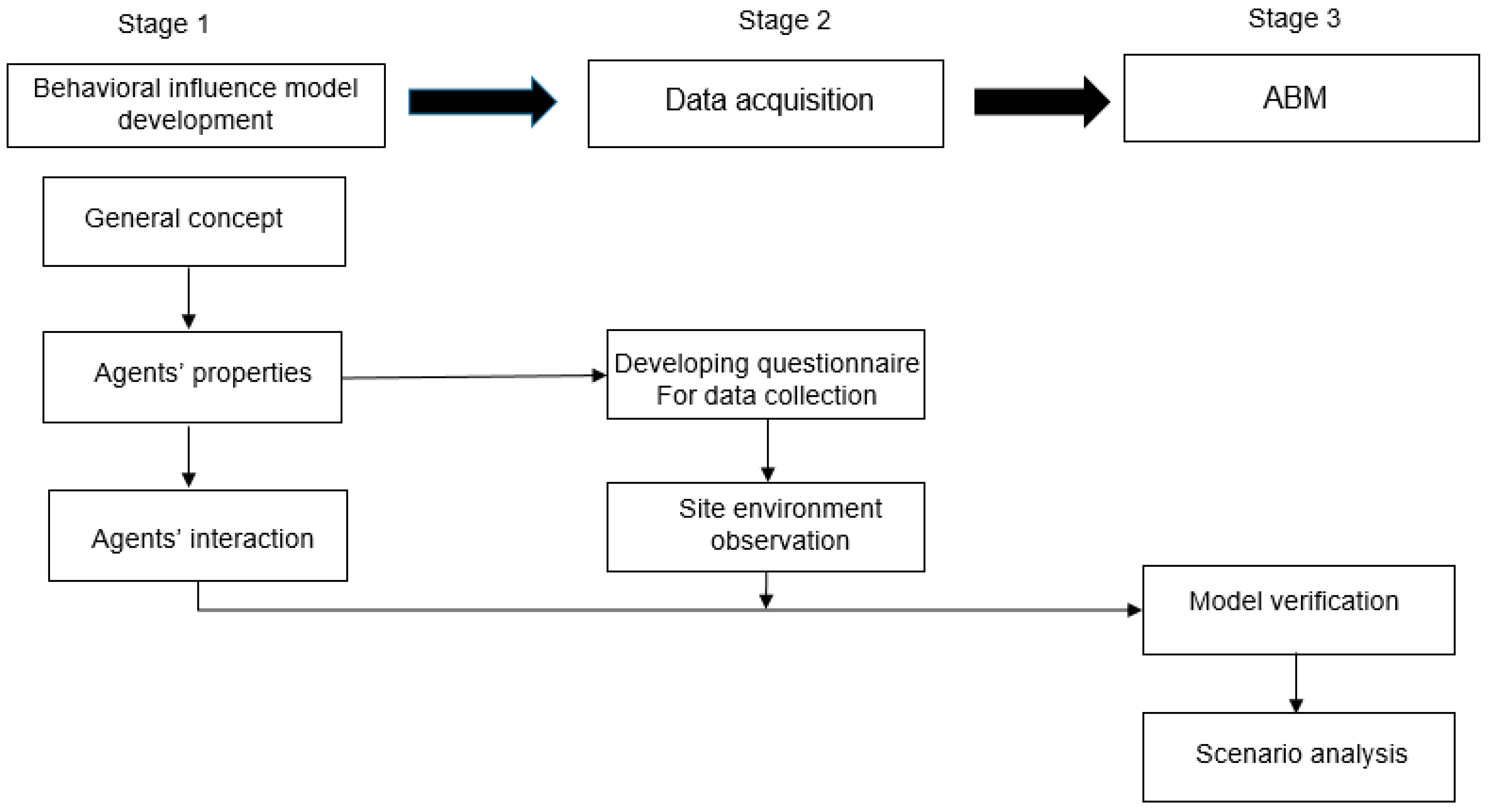

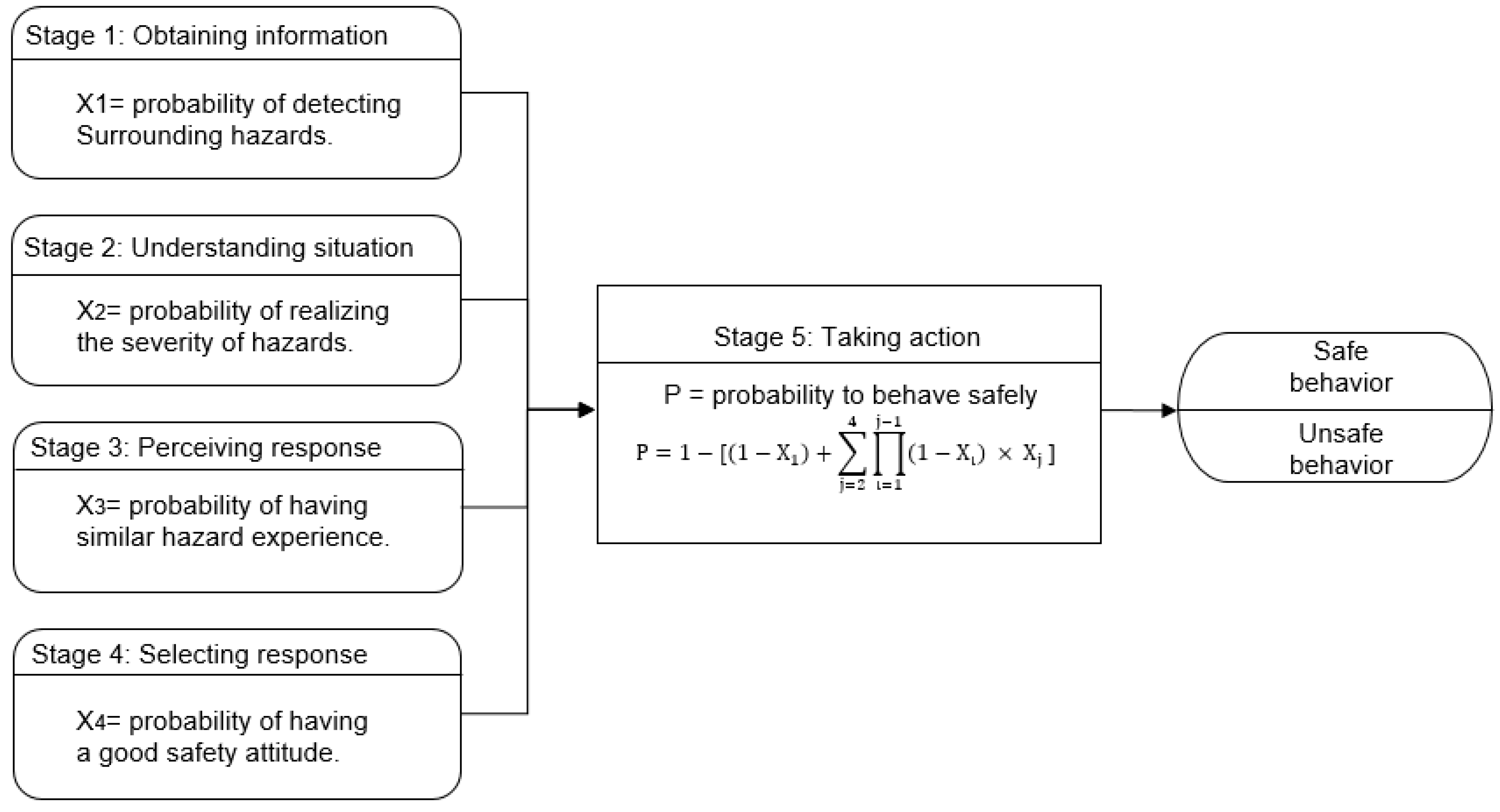


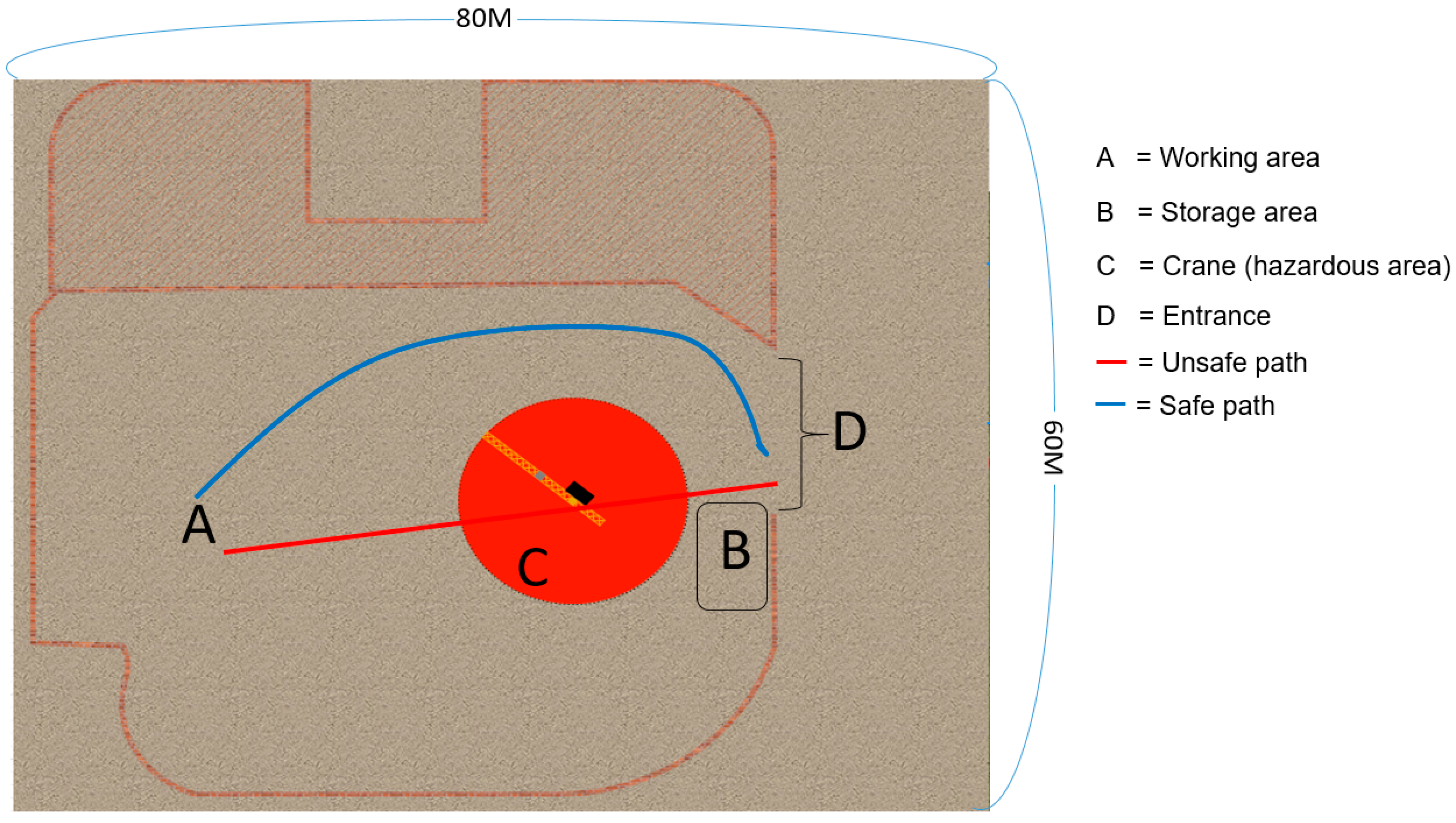
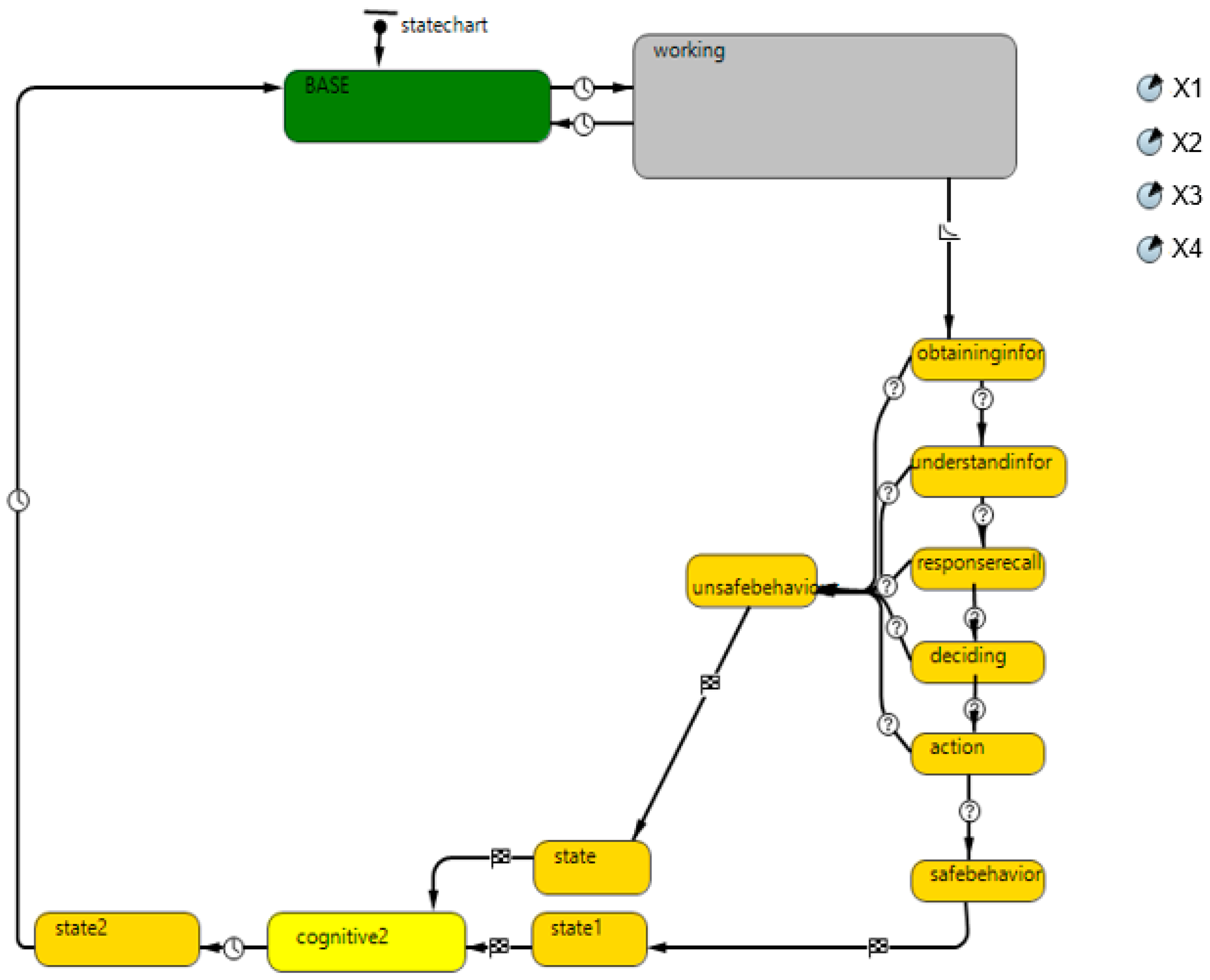
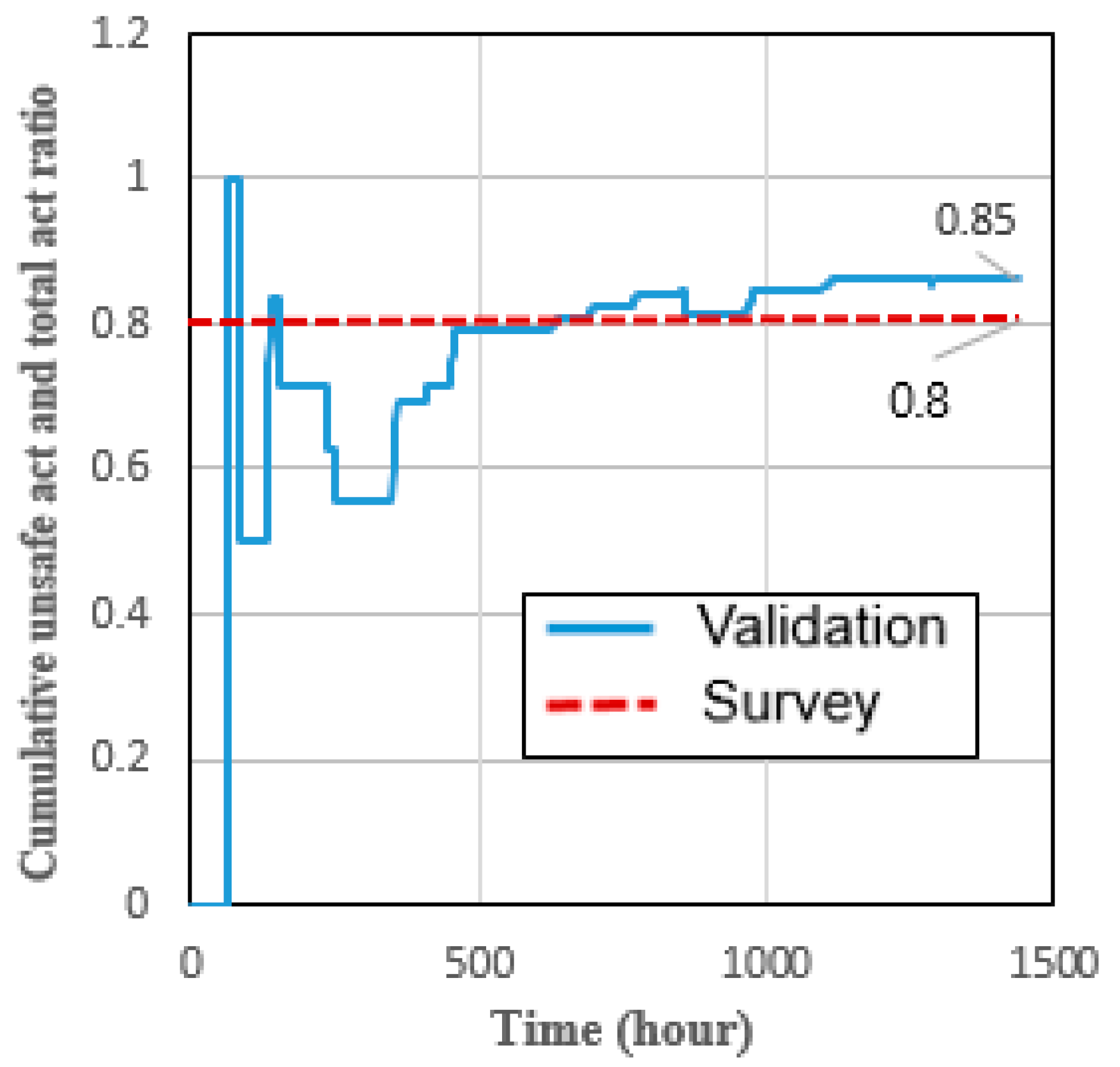

| Demographic Parameter | Category | Frequency | % |
|---|---|---|---|
| Age | <30 | 29 | 32.2 |
| 30–45 | 40 | 44.4 | |
| >45 | 21 | 23.3 | |
| Role | Workers | 87 | 97 |
| Foreman | 3 | 3 | |
| Years of experience | <5 | 27 | 30 |
| 5–10 | 46 | 51 | |
| >10 | 17 | 19 | |
| Education | <High school | - | - |
| High school | 22 | 24.4 | |
| Tertiary | 64 | 71.1 | |
| >Tertiary | 4 | 4.4 |
| Parameter | Number | Part 1. Item | (Normalized) | Value |
|---|---|---|---|---|
| LE | 1 | My foreman always works safely and adheres to all safety regulations. | 0.25 | 0.44 |
| 2 | Sometimes, especially when we are running behind schedule, my foreman engages in unsafe work. | 0.62 | ||
| SM | 3 | My foreman is attentive to the safety practices of the workers at the site. | 0.25 | 0.25 |
| 4 | My foreman advises those working unsafely to work safely and encourages those working safely to continue such behavior. | 0.25 | ||
| ST | 5 | My foreman uses previous safety incidents to advise the team about safety concerns at the site. | 0.45 | 0.36 |
| 6 | I find the foreman’s safety recommendations to be helpful. | 0.26 | ||
| 7 | Do you prefer to always work safely, whether or not the foreman is present or watching? | 0.24 | 0.24 | |
| 8 | Do you think it’s important to follow safety regulations at all times? | 0.23 | ||
| 9 | Do you anticipate your foreman or co-workers working safely at all times? | 0.25 | 0.25 | |
| 10 | Would you prefer to always respond to hazards the same way your foreman or co-workers would? | 0.25 | ||
| 11 | Do you think your knowledge of the site’s potential hazards has improved since the project’s beginning? | 0.31 | 0.28 | |
| 12 | Do you know the dangers of hazards associated with your work? | 0.24 | ||
| 13 | I have adequate information and teaching about the potential hazards in the work surroundings | 0.24 | 0.27 | |
| 14 | I have adequate consciousness to observe the potential hazards in the work surroundings | 0.29 | ||
| Part 2. Item | Yes | No | ||
| 15 | I usually take shortcuts on the site. | 72 | 18 |
| No. | Scenario | Parameter Value | |
| 1 | Scenario 1 | LE = 0.20, SM = 0.80, ST = 0.80 | Impact of LE |
| 2 | Scenario 2 | LE = 0.80, SM = 0.20, ST = 0.80 | Impact of SM |
| 3 | Scenario 3 | LE = 0.80, SM = 0.80, ST = 0.20 | Impact of ST |
Disclaimer/Publisher’s Note: The statements, opinions and data contained in all publications are solely those of the individual author(s) and contributor(s) and not of MDPI and/or the editor(s). MDPI and/or the editor(s) disclaim responsibility for any injury to people or property resulting from any ideas, methods, instructions or products referred to in the content. |
© 2023 by the authors. Licensee MDPI, Basel, Switzerland. This article is an open access article distributed under the terms and conditions of the Creative Commons Attribution (CC BY) license (https://creativecommons.org/licenses/by/4.0/).
Share and Cite
Nwagbala, D.C.; Park, J.Y. A Study of the Foremen’s Influence on the Safety Behavior of Construction Workers Based on Cognitive Theory. Buildings 2023, 13, 1792. https://doi.org/10.3390/buildings13071792
Nwagbala DC, Park JY. A Study of the Foremen’s Influence on the Safety Behavior of Construction Workers Based on Cognitive Theory. Buildings. 2023; 13(7):1792. https://doi.org/10.3390/buildings13071792
Chicago/Turabian StyleNwagbala, Daniel Chukwunonso, and Jong Yil Park. 2023. "A Study of the Foremen’s Influence on the Safety Behavior of Construction Workers Based on Cognitive Theory" Buildings 13, no. 7: 1792. https://doi.org/10.3390/buildings13071792





